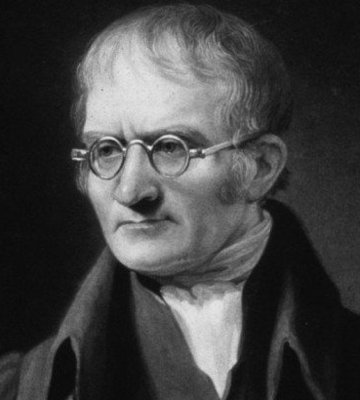- dalton (Da or D)
- an alternate name for the unified atomic mass unit (u or amu). The dalton is often used in microbiology and biochemistry to state
the masses of large organic molecules; these measurements are typically in
kilodaltons (kDa). It seems necessary to have such a unit, since "kilo-amu"
would be such a clumsy name. The SI accepts the dalton
as an alternate name for the unified atomic mass unit and specifies Da as
its proper symbol. The unit honors the English chemist John Dalton (1766-1844),
who proposed the atomic theory of matter in 1803.
- dam
- symbol for the dekameter (10 meters; see entry below), a metric unit of
distance.
- dan
- a traditional Chinese weight unit, previously spelled tan in many
English works. During the European colonial era the unit was equal to 100 catties or 133.333 pounds.
In modern China the dan is equal to 100 jin,
which is exactly 50 kilograms (110.231 pounds). The dan is the Chinese equivalent
of the European quintal or hundredweight.
- daN
- symbol for the decanewton or dekanewton (see below under dekanewton), a
common metric unit of force.
- Danjon scale
- a scale measuring the brightness (or rather, the darkness) of lunar eclipses,
devised by the French astronomer André Louis Danjon (1890-1967). Wikipedia has a description of the scale.
- daraf
- a unit of electrical elastance, which is the ability of an electric potential
to charge a capacitor. The daraf is equal to one volt of potential per coulomb
of charge (V/C). The name of the unit is "farad" spelled backwards, because
the elastance, in darafs, is 1 divided by the capacitance in farads. This
unit is not recognized as part of the SI.
- darcy
- a CGS unit of permeability. Permeability is the
extent to which a solid allows the flow of a fluid. This flow depends on the
properties of the solid and also on the dynamic viscosity of the fluid and
the difference in pressure driving the flow. One darcy is the permeability
of a solid through which one cubic centimeter of fluid, having a viscosity
of one centipoise, will flow in one second
through a section one centimeter thick and one square centimeter in cross
section, if the pressure difference between the two sides of the solid is
one atmosphere. It turns out that permeability
has the same units as area; since there is no SI unit
of permeability, square meters are used. One darcy is equal to about 0.98692
x 10-12 square meter. The unit is named for a French scientist,
H. Darcy (1803-1858), who did pioneering work in the study of permeability.
|

John Dalton (1766-1844)
English chemist and physicist
|


